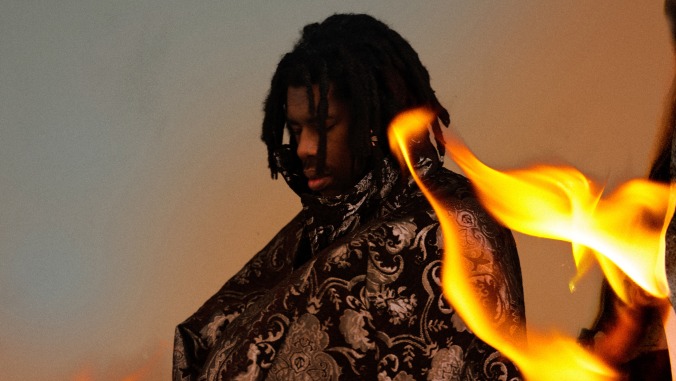Left-field cameos fuel Flying Lotus’ latest odyssey, Flamagra

Every Flying Lotus album unfolds as a hero’s journey into the great unknown. On Los Angeles, the producer’s 2008 breakthrough, he scoured his hometown’s electronic underground through a sci-fi lens. Then came the space jazz of Cosmogramma, the electro-folk meditation on dreams that was Until The Quiet Comes, and You’re Dead!. Cracking the Billboard albums chart at No. 19, that last one effectively introduced him to a mainstream audience, thanks in part to the excellent Kendrick Lamar single “Never Catch Me,” and effortlessly merged G-funk and slap bass with a futurist update of the Egyptian Book Of The Dead.
The theme of his new Flamagra is a cleansing eternal fire. In practice, it evokes his previous odysseys: the Afrocentric fusion of Roy Ayers and Andy Bey; the spiritual jazz of his late aunt, Alice Coltrane; Los Angeles’ electronic and hip-hop movement; and the funk, folk, and film soundtrack traditions that guide so much of his city’s scene. (We’re still waiting on the soundtrack to Kuso, his controversial 2017 live-action film inspired by Japan’s profanely debauched guro underground.) In the past, he has submerged these influences into an utterly unique sound. We’ve grown to expect the jittering 8-bit melodies, clipped beat-loop edits, and airy string-laden washes that define his cinematic vistas. But on Flamagra, the sonic signature that arguably made Flying Lotus the most innovative electronic producer of his era has evolved into a mere motor for his role as a postmillennial bandleader and a conductor of voices.
With a running time of over an hour, Flamagra is packed with left-field cameos and rangy interludes. Tierra Whack commands “Yellow Belly” with a gloriously weird appearance that shifts from a sashaying chorus to absurdist rhymes. “My shoes are untied… there I go tripping,” she speaks in an off-kilter voice. For “Black Balloons Reprise,” Denzel Curry sounds off in his unmistakably stiff, stentorian flow over an orchestral flip of “Ten Et Tiwa” from Alain Goraguer’s La Planète Sauvage. (The track also serves as a tribute to Quasimoto (a.k.a. Madlib)’s West Coast indie classic “Come On Feet.”) The David Lynch spoken-word piece “Fire Is Coming” has already made the rounds, and though it feels a bit like stunt casting, it adds to Flamagra’s unpredictable oddball flow. More cogent are Herbie Hancock’s frenetic keyboard riffing for “Pilgrim Side Eye,” which connects Flying Lotus’ postmodern electronic fusions with the iconic “Watermelon Man,” and George Clinton’s ruddy vocals for “Burning Down The House,” a track that doesn’t quite take off but feels necessary given Clinton’s role as father figure to a new generation of progressive P-funkateers.
Those vocal shots, more numerous than on any other FlyLo project, lie at the center of Flamagra’s appeal as a sprawling, vividly painted conflagration. To be sure, there are a handful of moments of instrumental whimsy—like when “Capillaries” slumps and bumps like a spaceship cruising through the cosmos—that remind you of Flying Lotus’ early coronation as a king of beat loops. However, creativity seems to pique when a vocalist enters the frame, whether it’s Anderson Paak sounding off over the lovelorn nu-funk melody of “More,” or Yukimi Nagano of Little Dragon soaring over the achingly beautiful electro-pop of “Spontaneous.” Then there’s “The Climb,” a lushly appointed yacht-jazz tune that’s as riveting as anything in George Duke’s catalog.
Nearly all of the tracks find FlyLo leading a team of musicians, including the Bruner brothers—bassist Stephen, a.k.a. “Thundercat.” and drummer Robert Jr.—as well as percussionist Niki Randa, strings arranger Miguel Atwood-Ferguson, keyboardist Brandon Coleman, and others. Their cumulative energy is felt when “Takashi” blossoms from squirrelly keyboard notes into a rousing stride rhythm, or in how the ornamental strings of “Say Something” shift into the hallucinatory soul of “Debbie Is Depressed.”
The net effect is a host of sounds and voices being drawn to Flamagra, much as a Quincy Jones opus involved dozens of contributors, some famous, others known only by professional reputation. If it all sounds vaporous at times, or even predictable to listeners long familiar with Flying Lotus’ sound, then at least it represents his growth into a full-fledged record producer, someone capable of straight-up great songwriting as well as engagingly electronic funk.